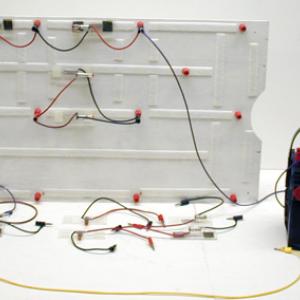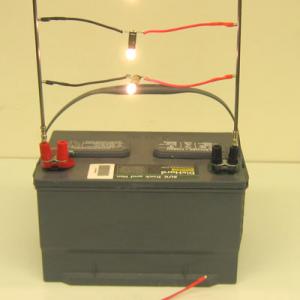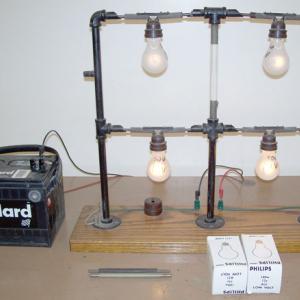College of Liberal Arts & Sciences
5F20.50 - Series and Parallel Light Bulbs
Video Credit: Jonathan M. Sullivan-Wood
The circuit board demo is an easier and less lethal version of the older demo.
Place the two iron "rabbit ears" into the outer banana connections on the battery. Connect the light bulbs with the magnetic connectors across the ears to show parallel bulb connections. Series connections can also be made with this apparatus.
Connect a 12 volt car battery to the stand. Turn on the circuit switch. The light bulbs may be arranged as desired or removed and replaced with the metal conduction rods. 12 volt DC bulbs of 25 watts, 50 watts, and 100 watts are available for use with this demonstration.
John Prineas has two circuits he uses on the 12 volt antique pipe stand. The first above is just a 50 watt and a 100 watt bulb in series with the battery to show the brightness difference in bulbs that have different resistances. The second uses three 50 watt bulbs. Two are in series with battery and will glow with the same brightness when switched on. Connect the bottom bulb so that it is in parallel with one of the series bulbs and one bulb glows bright and the bulbs that are in parallel will glow dimly. A voltmeter is also added to this demonstration so that you may measure the voltages at any point in these circuits.
NOTE: The original variation of this demonstration used 120 volts AC. We have converted this to 12 VDC for obvious safety reasons. Since the 12 VDC bulbs require larger currents for operation, the 12 volt car battery is the power supply of choice. You will probably have to polish all the connections on the bulbs and the stand so that they make good connections during operation.
- Greg C. Jacobs, "Rank the Voltage Across Light Bulbs … Then Set Up the Live Experiment", TPT, Vol. 56, #2, Feb. 2018, p. 120.
- Brandon Mitchell, Robert Ekey, Roy McCullough, William Reitz, "A Fan-tastic Quantitative Exploration of Ohm's Law", TPT, Vol. 56, #2, Feb. 2018, p. 75.
- Robert Ekey, Andrea Edwards, Roy McCullough, William Reitz, Brandon Mitchell, "A Fan-tastic Alternative to Bulbs: Learning Circuits With Fans, TPT, Vol. 55, #1, Jan. 2017, p. 13.
- Andrew Roberts and Dan MacIsaac, "Know Your Bulbs!", TPT, Vol. 55, #4, Apr. 2017, p. 231.
- J. Christopher Moore and Louis J. Rubbo, "Modeling Hidden Circuits: An Authentic Research Experience in One Lab Period", TPT, Vol. 54, #7, Oct. 2016, p. 423.
- Paul Hewitt, "Answer to January 2014 Figuring Physics Question", TPT, Vol. 52, #2, Feb. 2014, p. 120.
- Aaron Schuetz, "Cascading Failure in Holiday Lights", TPT, Vol. 51, #3, Mar. 2013, p. 186.
- Martha Lietz, "Make a Mystery Circuit with a Bar Light Fixture", TPT, Vol. 45, #4, Apr. 2007, p. 244.
- Tony Minich, "Conceptualizing Series and Parallel Circuits Through 3-D Modeling", TPT, Vol. 43, #7, Oct. 2005, p. 448.
- Hans Pfister, "Illustrating Electric Circuit Concepts with the Glitter Circuit", TPT, Vol. 42, #6, Sept. 2004, p. 359.
- Paul Hewitt, "Figuring Physics: Direct Current", TPT, Vol. 42, #3, Mar. 2004, p. 136.
- Kevork Spartalian, "Rectangles in Physics", TPT, Vol. 41, #7, Oct. 2003, p. 390.
- Thomas B. Greenslade Jr., "Additional References", TPT, Vol. 41, #7, Oct. 2003, p. 380.
- Dean Livelybrooks, "'Feel' the Difference Between Series and Parallel Circuits", TPT, Vol. 41, #2, Feb. 2003, p. 102.
- Art Hovey, "Nomographs", TPT, Vol. 41, #1, Jan. 2003, p. 4.
- Thomas B. Greenslade Jr., "A Nomograph for Resistors in Parallel", TPT, Vol. 40, #8, Nov 2002, p. 458.
- Paul Hewitt, "Figuring Physics: Ohm's Law", TPT, Vol. 40, #3, Mar. 2002, p. 184.
- Tom Russell, "In Praise of Simple Physics", TPT, Vol. 38, #5, May 2000, p. 306.
- David T. Kagan, "A Cheap Simple Ammeter for Batteries-and-Bulbs Activities", TPT, Vol. 38, #4, April 2000, p. 204.
- Camille L. Wainwright, "Gender Indifference", TPT, Vol. 37, #3, Mar. 1999, p. 131.
- Dean Baird, "Males, Females, and Wrong Answers", TPT, Vol. 37, #2, Feb. 1999, p. 67.
- Thomas R. Brown, Timothy F. Slater, and Jeffrey P. Adams, "Gender Differences with Batteries and Bulbs", TPT, Vol. 36, #8, Dec. 1998, p. 526.
- Walter R. Steger and Suk R. Hwang, "A Series-Parallel Demonstration", TPT, Vol. 33, #9, Dec. 1995, p. 590.
- Clifton Keller and Yimin Wang, "A Golden Oldie—A Black Box Circuit", TPT, Vol. 32, #4, Apr. 1994, p. 222.
- Richard Forrest, "An Apparatus for Teaching Series and Parallel Circuits", TPT, Vol. 30, #2, Feb. 1992, p. 84.
- John W. Jewett, "Get the LED Out", TPT, Vol. 29, #8, Nov. 1991, p. 530.
- Robert P. Baumann and Saleh Adams, "Misunderstandings of Electric Current", TPT, Vol. 28, #5, May 1990, p. 334.
- Paul Hewitt, "Figuring Physics", TPT, Vol. 26, #5, May 1988, p. 314.
- Paul Hewitt, "Parallel Circuit", TPT, Vol. 24, #3, Mar. 1986, p. 179, also A Potpourri of Physics Teaching Ideas - Electricity and Magnetism, p. 169.
- Clifton Keller, "Mysterious Light in Series and Parallel", TPT, Vol. 18, #6, Sept. 1980, p. 464.
- Harry G. Miller, "Try a Socket", TPT, Vol. 18, #5, May 1980, p. 336.
- Norman Fredette and John Lochhead, "Student Conceptions of Simple Circuits", TPT, Vol. 18, #3, Mar. 1980, p. 194.
- Renato Lichtenstein, "A Circuit Demonstration", TPT, Vol. 16, #1, Jan. 1978, p. 35, also A Potpourri of Physics Teaching Ideas - Electricity and Magnetism, p. 153.
- James Evans, "Teaching Electricity with Batteries and Bulbs", TPT, Vol. 16, #1, Jan. 1978, p. 15.
- G. D. Freier and F. J. Anderson, "Eh-1", A Demonstration Handbook for Physics.
- Earl R. Feltyberger et al., "Circuit Puzzles", Teaching About D. C. Electric Circuits, p. 4.3.
- Don Rathjen and Paul Doherty, "Circuit Workbench", Square Wheels, 2002, p. 9.
- David Kutliroff, "90. Illustrate the Effect of Resistors in Series and Parallel", 101 Classroom Demonstrations and Experiment For Teaching Physics, p. 200.
- Borislaw Bilash II and David Maiullo, "Series versus Parallel Circuits", A Demo a Day: A Year of Physics Demonstrations, p. 276.
- Borislaw Bilash II and David Maiullo, "Blowing the Bulb Brighter", A Demo a Day: A Year of Physics Demonstrations, p. 273.
- Janice VanCleave, "68. How a Flashlight Works", Teaching the Fun of Physics, p. 104.
- Robert Ehrlich, "L.7. Light Bulbs in Series and in Parallel", Turning the World Inside Out and 174 Other Simple Physics Demonstrations, p. 149 - 150.
- W. Bolton, "Wheatstone Bridge", Book 4 - Electricity, Physics Experiments and Projects, 1968, p. 3 - 4.
- Rudolf F. Graf, "Series and Parallel Circuits", Safe and Simple Electrical Experiments, p. 107.
- Borislaw Bilash II, “Series versus Parallel Circuits“, A Demo A Day – A Year of Physical Science Demonstrations, p. 284.
Disclaimer: These demonstrations are provided only for illustrative use by persons affiliated with The University of Iowa and only under the direction of a trained instructor or physicist. The University of Iowa is not responsible for demonstrations performed by those using their own equipment or who choose to use this reference material for their own purpose. The demonstrations included here are within the public domain and can be found in materials contained in libraries, bookstores, and through electronic sources. Performing all or any portion of any of these demonstrations, with or without revisions not depicted here entails inherent risks. These risks include, without limitation, bodily injury (and possibly death), including risks to health that may be temporary or permanent and that may exacerbate a pre-existing medical condition; and property loss or damage. Anyone performing any part of these demonstrations, even with revisions, knowingly and voluntarily assumes all risks associated with them.


